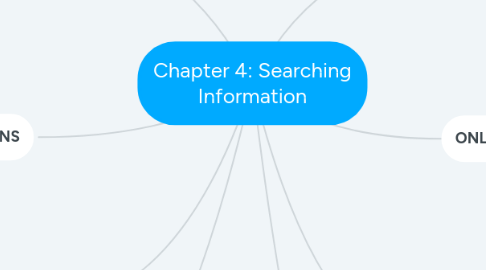
1. SEARCH ENGINES
1.1. Basic concept in search engine is by using keyword search.
1.2. Basic rules in seeking information
1.2.1. 1. Use "advanced" search tools whenever possible. 2. Search for phrase or limit the words phrases. 3. SImplify your keyword search. 4. Try to seek for synonymous words in case your search failed.
1.3. Example of search engine available
1.3.1. 1. Google. 2. Yahoo. 3. Ask Network
2. SEARCH OPTIONS
2.1. Boolean Operators
2.1.1. Used to connect and define the relationship between your search terms.
2.1.2. AND
2.1.3. OR
2.1.4. NOT
3. CLASSIFICATION SCHEME
3.1. Used by librarian to sort their library materials to the accordance class or subject or field area.
3.2. Used of classification scheme?
3.2.1. Sorting books and ease the retrieval process
3.2.2. Identify book by call number.
4. DCC (Dewey Decimal Classificaiton)
4.1. Invented by Melvin Dewey in 1876.
4.2. Not widely use in a academic libraries.
4.3. More use in national libraries such as Perpustakaan Negara and public library such s state library.
4.4. Example of listing subjects and main classes:
4.4.1. 000- Generalities
4.4.2. 100- Philosophy and psychology
4.4.3. 200 Religion
4.4.4. 300 Social sciences
5. OPAC
5.1. An acronym for Online Public
5.1.1. Searching criteria?
5.1.1.1. 1 Keyword. 2. Subject. 3. Title. 4. Author. 5. Publisher. 6. Publisher location. 7. ISBN. 8 Barcode.
5.2. Function ? 1.May reserve the book to borrow after the current borrower. 2. Still need to go to the library to get the book that you have reserved and present the book to the circulation desk or book checker machine to borrow it.
5.3. Advantages?
5.3.1. 1. Provide more searching option such as author, title and keywords. 2. Easy retrieval by using the call number of the book. 3. Easy to know the status of the books. 4. Time saving. 5. Eliminate duplication of book's record.
6. ONLINE DATABASE
6.1. Can access digital collection such as past semesters' exam paper, theses, journals, articles and e-books.
7. LCC (Library Congress Classification)
7.1. Uses alphabet as its main classes and number as its sub-classes.
7.2. Example of main classes in LCC:
7.2.1. A. General works
7.2.2. B. Philosophy, Psychology, Religion
7.2.3. C. Auxiliary sciences of history.
7.2.4. D. History: General and Old World
7.3. LCC Call Number
7.3.1. First line
7.3.2. Second line
7.3.3. Third line
7.3.4. Fourth line
